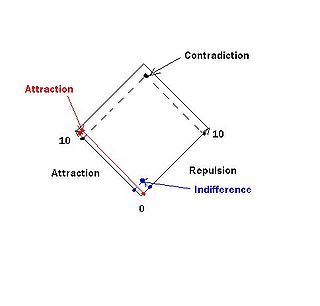
Diamond of opposites
Encyclopedia

Psychodrama
Psychodrama is a method of psychotherapy in which clients utilize spontaneous dramatization, role playing and dramatic self-presentation to investigate and gain insight into their lives. Developed by Jacob L. Moreno, M.D. psychodrama includes elements of theater, often conducted on a stage where...
groups. This tool can illuminate the presence of contradictions in processes that cannot be detected by any single questionnaire item using a traditional format such as the Likert scale
Likert scale
A Likert scale is a psychometric scale commonly involved in research that employs questionnaires. It is the most widely used approach to scaling responses in survey research, such that the term is often used interchangeably with rating scale, or more accurately the Likert-type scale, even though...
. The diamond of opposites is a sociometric
Sociometry
Sociometry is a quantitative method for measuring social relationships. It was developed by psychotherapist Jacob L. Moreno in his studies of the relationship between social structures and psychological well-being....
scaling method
Scale (social sciences)
In the social sciences, scaling is the process of measuring or ordering entities with respect to quantitative attributes or traits. For example, a scaling technique might involve estimating individuals' levels of extraversion, or the perceived quality of products...
that simultaneously measures positive and negative responses to a statement.
Unlike traditional question formats, especially the semantic differential
Semantic differential
Semantic differential is a type of a rating scale designed to measure the connotative meaning of objects, events, and concepts. The connotations are used to derive the attitude towards the given object, event or concept.-Semantic differential:...
format where the respondent must choose a point on a one-dimensional scale anchored by two semantically opposite terms, the diamond of opposites allows the respondent to express attraction and repulsion independently. In this format, the stem describes an object, person or situation in relation to which the respondent is asked to indicate their degree of attraction and repulsion. The two variables are plotted on two orthogonal axes.
Example
mathematics problems- Indicate your level of attraction on a scale of 1 (low) to 10 (high)
- Indicate your level of repulsion on a scale of 1 (low) to 10 (high)
- The respondent indicates attraction of x' = 8, and repulsion of y' = 5.
- The point (x',y') represents the current attitude of the respondent toward mathematics problems.

